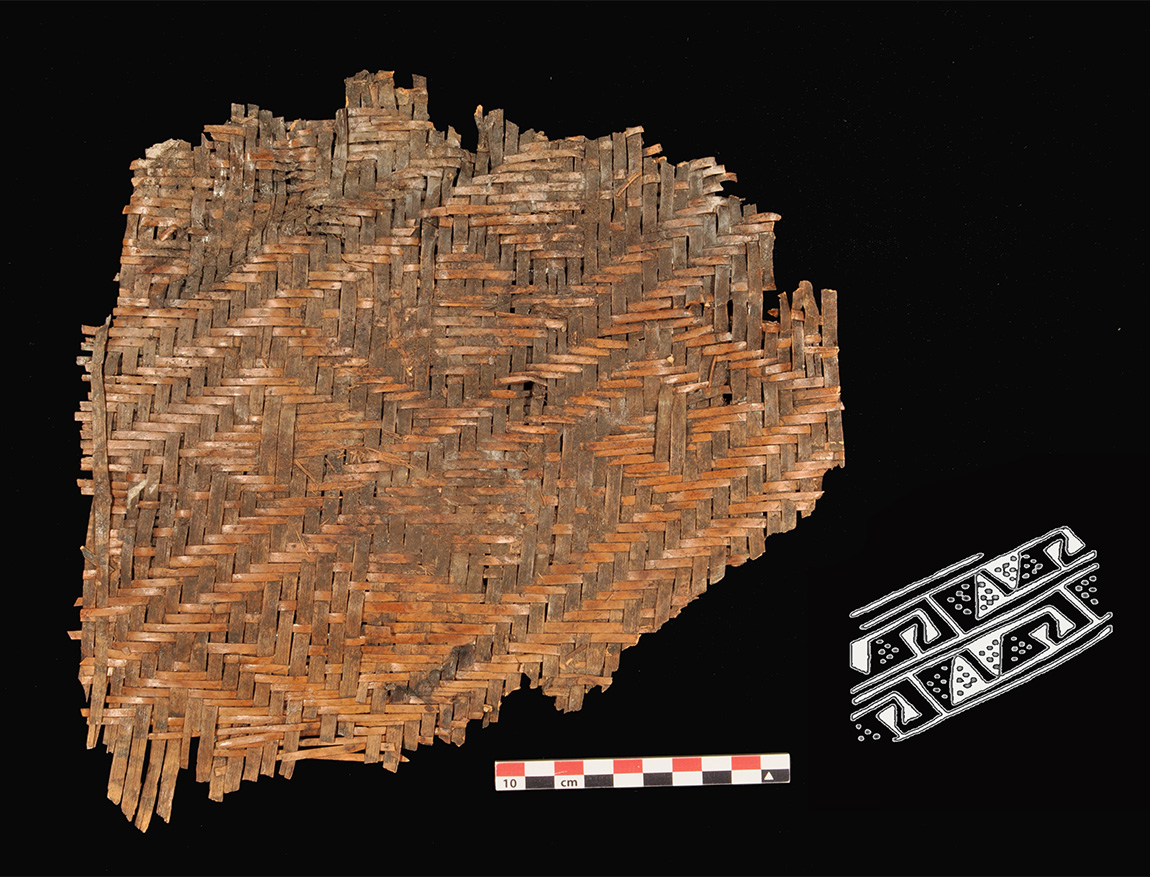
Elizabeth T. Horton
Artifact of the Month - October 2019
While many are familiar with the intricate, complex rivercane basketry made by contemporary Indigenous peoples of the southeastern United States, few recognize the deep roots of this artistic tradition. Often associated with Chitimacha and Cherokee artists today, rivercane weaving was once a widespread, integral part of peoples’ lives. Some of the oldest evidence for weaving with rivercane comes from places like Mammoth Cave in Kentucky, where one day, over 3,000 years ago, someone left a rivercane basket overturned deep in the passages of the cave system. This is one of few radiocarbon dated Archaic period (2630±44 rcybp) rivercane baskets, but imprints of cane baskets in mound deposits at Poverty Point in Louisiana hint at widespread use of rivercane basketry by the end of the Archaic.
Cane, or Arundinaria sp., is a North American member of the bamboo family. There are three species of cane; A. giganteae, A. tecta, and A. appalachiana. Because of its strength and flexibility, cane became a critical resource for Southeastern societies. Enormous stands of rivercane once sustained basic aspects of peoples’ lifeways, providing construction material for houses and material goods such as storage and carrying baskets, mats, arrow shafts, razors, blow guns, beads, rasps, hafts for tools, and much more.
In the Ozark Plateau, dry conditions in caves and rock shelters have preserved an extensive archeological record of cane used for material goods, including unique items like the carved flute from Breckenridge, as well as diverse and often beautiful rivercane basketry. Most of the basket and mat fragments from the Ozark bluff shelters are plain. But some exhibit evidence of complex artistry in weaving going back hundreds and even thousands of years, at least to the Middle Woodland (ca. 200 BC–AD 200). Pictured here are two basket fragments recovered from Cobb Cave in Newton county (3NW6) in the 1930s by Sam Dellinger’s crews (Figures 1 and 2). These baskets are thought to be from the Mississippi period (ca. AD 1000–1500), based on the AD 1000–1200 dates for other basketry from Cobb Cave.
While it is likely that every member of a community would have had some basic fiber processing and fabric production skill, rivercane basket weaving in most Indigenous Southeastern societies today is strongly associated with women’s labor and artistry. Weavers, then and now, have to be able to calculate complex mathematical equations to create these “structural design” baskets—baskets made with designs woven into them rather than painted or sewn on later. Weavers must determine exactly how many cane peels they will need to create the right size and shape, how many peels to repeat a design across the surface of a basket seamlessly and without error. A weaver calls on years of experience and training, often learned within families and communities, reproducing long-held traditions in how each design motif should look and how to execute it, what shape and size specific basket types should be, and how rims should be finished. But at times, we also see weavers experimenting with designs and materials to create new and unique basket styles, designs, and weaving techniques.

The two basket fragments from Cobb Cave exemplify this complex artistry based in both ancient traditions and new innovations. These Mississippi period baskets are woven using two very common techniques seen in Ozark Plateau basketry since the Woodland period. The basic weave count for both baskets is an uneven weave; 4/1, or over/under four peels and over/under one peel. This weave count produces a “dot in field” effect seen in both baskets. Alterations in the weave count created designs like the repeated triangle motifs in the Figure 1 basket, and the sinuous legs of the spider motif in the Figure 2 basket. Both baskets were also made utilizing another technique seen in earlier Woodland period basketry of the region: flipping one set of the cane peels. This technique uses the different surface texture of the interior and exterior of the cane to highlight the woven pattern.
There are also unique aspects to both baskets not seen in others from the Ozark Plateau. These indicate innovations within a tradition that was already over a thousand years old by the time these baskets were made. They also hint at some relationships between the makers of these baskets and communities outside of the Ozarks. First is the use of cane peels of different widths to make elongated designs. Another is the use of a twined finish below the rim. The basketry fragments from Cobb Cave are the only documented occurrence of this technique in Ozark bluff shelters, with only one other known example in Arkansas (at the Late Mississippian Belle Meade site, 3CT30).
The last unique aspect highlighted here is the presence of a zoomorphic spider design on the Figure 2 basket. While not uncommon in Mississippian iconography on other objects like engraved shell or embossed copper plates, the Cobb Cave basket is the only known use of this motif in archeological rivercane basketry. With her dot-in-circle motif abdomen and eyes, the spider, whose eight legs arch gracefully across the surface of the basket, mimics other known depictions such as a copper plate from Parkin. From historic narratives we know the spider is frequently understood as a female entity, the weaver, and that in some traditions, she carries life-sustaining fire to humanity. The weaver of this basket had to know how to reproduce that motif in the mathematical formula imposed by the constraints of interlaced weaving. The weaver had to translate placement of arched legs, abdomen, and eyes into a discrete line-by-line production. Each pass of each peel followed a precise over and under count to elegantly reproduce the image of a powerful being on the surface of the basket.
Contemporary Southeastern Indigenous weavers still work from deep-time practices and their own artistic sensibilities, continuing an artistic tradition that reaches back thousands of years to their ancestors’ knowledge of rivercane. Once a prominent aspect of the Southeast landscape, canebrakes are described in early European accounts as extending miles deep from a riverbank and covering thousands of acres of bottomland. Today giant rivercane is reduced to small and discontinuous patches. The collapse of the vast, extensive canebrakes of the Southeast by the late 1800s is a well-known phenomenon, driven by colonial agricultural techniques and the introduction of cattle and hogs. Possibly the most significant change in the landscape is related to removal of Indigenous peoples from regions where they had tended and utilized canebrakes for thousands of years. Modern land use—industrial-scale agriculture and expanding urban development—continue to inhibit growth of large extensive canebrakes. Contemporary Southeastern basket weavers face difficulty in finding stands that are large enough and dense enough to produce the right size cane culms necessary for basketry production. This is a reminder that cultural heritage is not just a matter of discrete archeological sites, or artifacts in a museum or on a website, but also the living plants and landscapes that have sustained an art form for many thousands of years.
 Collections and items in our institution have incomplete, inaccurate, and/or missing attribution. We are using this notice to clearly identify this material so that it can be updated, or corrected by communities of origin. Our institution is committed to collaboration and partnerships to address this problem of incorrect or missing attribution. For more information, visit localcontexts.org.
Collections and items in our institution have incomplete, inaccurate, and/or missing attribution. We are using this notice to clearly identify this material so that it can be updated, or corrected by communities of origin. Our institution is committed to collaboration and partnerships to address this problem of incorrect or missing attribution. For more information, visit localcontexts.org.
 The Arkansas Archeological Survey is committed to the development of new modes of collaboration, engagement, and partnership with Indigenous peoples for the care and stewardship of past and future heritage collections.
The Arkansas Archeological Survey is committed to the development of new modes of collaboration, engagement, and partnership with Indigenous peoples for the care and stewardship of past and future heritage collections.
 The TK Notice is a visible notification that there are accompanying cultural rights and responsibilities that need further attention for any future sharing and use of this material. The TK Notice may indicate that TK Labels are in development and their implementation is being negotiated. For more information about the TK Notice, visit localcontexts.org.
The TK Notice is a visible notification that there are accompanying cultural rights and responsibilities that need further attention for any future sharing and use of this material. The TK Notice may indicate that TK Labels are in development and their implementation is being negotiated. For more information about the TK Notice, visit localcontexts.org.
